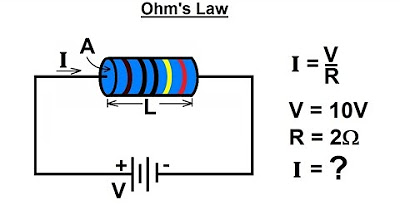O que é a resistência elétrica?
Summary
TLDRIn this video, the presenter explains the concept of electrical resistance in a simple and engaging way. Resistance is described as the opposition that conductors offer to the flow of electric current, with electrons moving through materials encountering resistance from atoms and other electrons. Factors affecting resistance, such as the conductor's length, thickness, and the type of material, are discussed, along with the effect of temperature. The video also introduces the concept of Joule's effect, where resistance generates heat. The content aims to clarify the fundamental principles of electrical resistance and its practical implications.
Takeaways
- 😀 Electrical resistance is the opposition to the flow of electric current through conductors.
- 😀 When electrons move through a conductor, they face resistance, which disrupts their smooth flow.
- 😀 The analogy of people trying to walk through a crowded hallway helps explain how electrons collide and slow down.
- 😀 Resistance leads to the generation of heat, known as the Joule effect, which occurs due to electron collisions.
- 😀 Longer cables result in higher resistance because electrons face more collisions over greater distances.
- 😀 The thickness (or cross-sectional area) of a conductor affects its resistance: thinner cables offer more resistance.
- 😀 Different materials offer different levels of resistance based on their atomic structure, which is known as resistivity.
- 😀 Temperature also affects resistance, with increased temperatures generally leading to higher resistance.
- 😀 The three main factors influencing resistance are conductor length, cross-sectional area, and material type.
- 😀 In some electrical calculations, temperature is a factor, but it’s often neglected in simpler cases, such as residential wiring.
- 😀 Understanding electrical resistance is crucial for designing efficient electrical systems and ensuring safety in circuits.
Q & A
What is electrical resistance?
-Electrical resistance is the opposition that conductors provide to the flow of electric current. It occurs as free electrons try to move through the conductor, facing resistance from both the atoms in the material and other free electrons.
How does electrical current behave in a conductor?
-Electrical current involves the movement of free electrons. While the electrons aim to move in a specific direction, they do not travel in a perfectly straight line. Instead, they move in multiple directions while still following the overall flow of current.
What is the role of atoms in electrical resistance?
-The atoms in a conductor obstruct the free flow of electrons. As electrons collide with the atoms in the material, it contributes to electrical resistance, much like people bumping into each other while trying to move through a crowded corridor.
What happens when electrons collide in a conductor?
-When electrons collide with each other or with atoms in the conductor, it causes resistance. This interaction leads to energy loss in the form of heat, which is known as the Joule effect.
What is the Joule effect?
-The Joule effect refers to the heat generated when electric current flows through a conductor and encounters resistance. The collisions between electrons and atoms produce energy that dissipates as heat.
How does the length of a conductor affect electrical resistance?
-The longer the conductor, the higher the electrical resistance. This is because electrons encounter more obstacles (atoms and other electrons) over a greater distance, losing more energy in the process.
What effect does the thickness of a conductor have on resistance?
-The thickness (or cross-sectional area) of a conductor inversely affects its resistance. A thicker conductor allows more electrons to pass through more easily, reducing resistance.
What is resistivity, and how does it influence resistance?
-Resistivity is a property of a material that determines how much it resists the flow of electric current. Materials with high resistivity offer greater resistance, while materials with low resistivity allow current to flow more easily.
How does temperature affect electrical resistance?
-Temperature can modify the resistance of a material. In general, as temperature increases, the resistance of most materials increases as well, due to more frequent collisions between electrons and atoms.
What are the three main factors that influence electrical resistance in a conductor?
-The three main factors that affect electrical resistance are the length of the conductor, its cross-sectional area (thickness), and the material type (resistivity). Temperature can also influence resistance, though it is a secondary factor in many calculations.
Outlines

هذا القسم متوفر فقط للمشتركين. يرجى الترقية للوصول إلى هذه الميزة.
قم بالترقية الآنMindmap

هذا القسم متوفر فقط للمشتركين. يرجى الترقية للوصول إلى هذه الميزة.
قم بالترقية الآنKeywords

هذا القسم متوفر فقط للمشتركين. يرجى الترقية للوصول إلى هذه الميزة.
قم بالترقية الآنHighlights

هذا القسم متوفر فقط للمشتركين. يرجى الترقية للوصول إلى هذه الميزة.
قم بالترقية الآنTranscripts

هذا القسم متوفر فقط للمشتركين. يرجى الترقية للوصول إلى هذه الميزة.
قم بالترقية الآنتصفح المزيد من مقاطع الفيديو ذات الصلة

Electrical Engineering: Basic Laws (2 of 31) Ohm's Law

Ohm’s Law Tutorial with easy practice problems | Basic Circuits

Percobaan : Tekanan Udara

Listrik Dinamis-Beda Potensial dan Penghantar Listrik (Part 2)

Electrician interview questions and answers, Electrical interview basic & beginners, Electrical test

O que é TENSÃO, CORRENTE, RESISTÊNCIA E POTÊNCIA, ELÉTRICA?
5.0 / 5 (0 votes)
